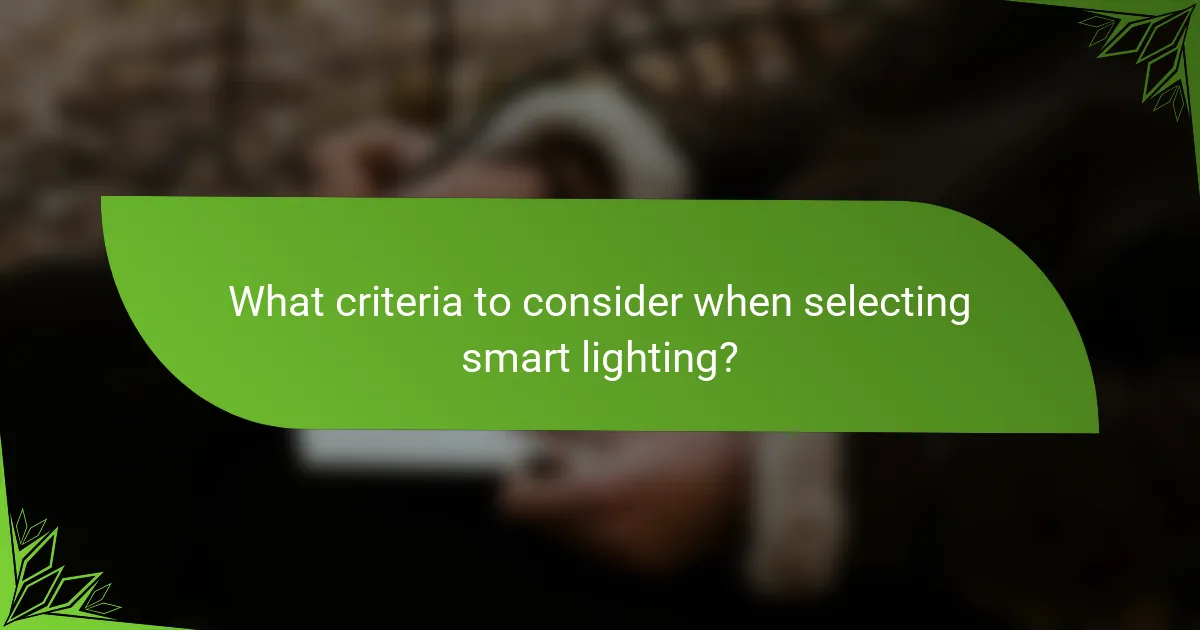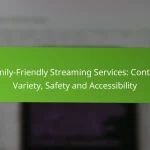Smart lighting plays a crucial role in enhancing self-casting by allowing content creators to adjust brightness and color temperature, ultimately improving video quality and viewer engagement. By selecting the right smart lighting systems and positioning them effectively, users can achieve a professional look in their broadcasts, making their content more appealing and polished.

How does smart lighting impact self-casting?
Smart lighting significantly enhances self-casting by providing adjustable brightness and color temperature, which can improve video quality and viewer engagement. By tailoring lighting to specific needs, content creators can achieve a professional look and feel in their broadcasts.
Enhanced visibility for content creators
Smart lighting allows content creators to control the intensity and direction of light, ensuring they are well-lit during self-casting. This capability reduces shadows and highlights important features, making the creator more visually appealing on camera.
For optimal results, consider using softbox lights or ring lights that can be adjusted for brightness and color. Aim for a color temperature between 5000K and 6500K to mimic natural daylight, which is flattering for skin tones.
Improved mood and ambiance
The ability to change lighting colors and intensities can significantly affect the mood of a self-casting environment. Warm tones can create a cozy atmosphere, while cooler tones can convey professionalism and clarity.
Experiment with different lighting setups to find what resonates best with your audience. For instance, using warmer lights during casual streams can foster a relaxed vibe, while brighter, cooler lights may be better suited for educational content.
Energy efficiency benefits
Smart lighting systems often utilize LED technology, which consumes less energy compared to traditional bulbs. This efficiency not only lowers electricity bills but also contributes to a more sustainable environment.
When selecting smart lighting, look for Energy Star-rated products that can save up to 80% more energy than incandescent bulbs. Additionally, consider integrating smart controls that allow for scheduling or remote operation to further enhance energy savings.

What are the best smart lighting systems for self-casting?
The best smart lighting systems for self-casting include Philips Hue, Nanoleaf, and LIFX. Each of these brands offers unique features that enhance the lighting experience, making them suitable for various creative setups.
Philips Hue for customizable lighting
Philips Hue is renowned for its extensive customization options, allowing users to adjust brightness, color, and even create scenes that match specific moods. The system integrates seamlessly with smart home devices, enabling voice control and automation.
Consider starting with a starter kit that includes a hub and a few bulbs. This setup allows you to expand your system gradually by adding more bulbs or accessories as needed. Philips Hue bulbs typically connect via Zigbee, ensuring reliable performance without heavy Wi-Fi usage.
Nanoleaf for creative designs
Nanoleaf stands out for its artistic and modular lighting panels that can be arranged in various shapes. This brand is ideal for those looking to make a statement with their lighting, as the panels can create dynamic displays that sync with music and other media.
When setting up Nanoleaf, consider the layout of your space to maximize visual impact. The panels are easy to install and can be controlled via an app, allowing for quick adjustments and scene changes. Keep in mind that while they are visually striking, they may require more planning for effective placement compared to traditional bulbs.
LIFX for vibrant colors
LIFX bulbs are known for their bright, vivid colors and do not require a hub, making them a convenient choice for many users. They connect directly to Wi-Fi, allowing for easy setup and control through a smartphone app.
For optimal use, ensure your Wi-Fi signal is strong in the area where you plan to install LIFX bulbs. These bulbs offer a wide range of colors and effects, making them perfect for creating immersive environments. However, be aware that they may consume more power than other smart bulbs, so consider energy efficiency if that is a concern.

How to set up smart lighting for self-casting?
Setting up smart lighting for self-casting involves selecting appropriate smart bulbs, integrating them with your existing smart home system, and positioning them effectively to enhance your on-camera presence. This ensures optimal lighting conditions that can significantly improve the quality of your broadcasts or recordings.
Choosing the right smart bulbs
When selecting smart bulbs for self-casting, consider brightness, color temperature, and compatibility with your devices. Look for bulbs that offer adjustable brightness levels and a color temperature range from warm (around 2700K) to cool (up to 6500K) to create the desired ambiance.
Popular options include LED smart bulbs from brands like Philips Hue, LIFX, and Wyze. These bulbs typically connect via Wi-Fi or Zigbee, allowing for easy control through apps or voice assistants.
Integrating with smart home systems
To maximize the benefits of smart lighting, integrate your bulbs with a smart home system, such as Google Home, Amazon Alexa, or Apple HomeKit. This allows you to control your lighting through voice commands or automation routines.
Ensure that your smart bulbs are compatible with your chosen system. For example, if you use Alexa, verify that the bulbs can connect to the Alexa app for seamless control. Setting up routines can automate lighting changes based on your schedule or specific activities.
Positioning lights for optimal effect
Positioning your smart lights correctly is crucial for achieving the best lighting for self-casting. Place lights at a 45-degree angle from your face to minimize shadows and create a flattering look. Using a combination of key lights and fill lights can enhance the overall effect.
Consider using softbox lights or ring lights for even illumination. Experiment with different placements to find the setup that highlights your features while avoiding glare or harsh shadows. A well-lit environment can significantly improve viewer engagement and video quality.

What are the benefits of smart lighting in self-casting?
Smart lighting offers significant advantages for self-casting, enhancing both the quality of the visual output and the convenience of the setup. By allowing precise control over brightness and color temperature, smart lighting can create the ideal ambiance for recording or streaming.
Flexibility in lighting adjustments
Smart lighting systems enable users to easily adjust brightness and color temperature to suit different moods or requirements. This flexibility is crucial for self-casting, where lighting can dramatically affect the quality of video content. For instance, a warmer light can create a cozy atmosphere, while cooler tones can enhance clarity and focus.
Many smart lighting solutions allow for preset configurations, making it simple to switch between different lighting setups with just a tap or voice command. This adaptability can save time and improve the overall production quality.
Remote control capabilities
With smart lighting, users can control their lighting setup remotely, which is particularly beneficial for self-casting. Whether using a smartphone app or voice commands through a smart assistant, you can adjust the lighting without needing to be physically present. This feature is especially useful during live streams or recordings where adjustments may be needed on the fly.
Remote control also allows for experimentation with different lighting setups without interrupting the flow of content creation. This can lead to more dynamic and engaging presentations.
Compatibility with smart devices
Smart lighting systems are often compatible with a range of smart devices, including cameras, microphones, and home automation systems. This integration can streamline the self-casting process, allowing for synchronized lighting changes based on audio cues or camera settings.
For example, some systems can automatically adjust lighting based on the time of day or the presence of people in the room. This compatibility not only enhances convenience but also improves the overall production quality by ensuring optimal lighting conditions at all times.

What criteria to consider when selecting smart lighting?
When selecting smart lighting, consider factors such as brightness, color temperature, and compatibility with existing technology. These elements will significantly impact both the functionality and ambiance of your space.
Brightness and color temperature
Brightness is measured in lumens, and for most residential spaces, a range of 800 to 1600 lumens is typically sufficient. Color temperature, measured in Kelvins (K), affects the mood of a room; warmer tones (2700K-3000K) create a cozy atmosphere, while cooler tones (4000K-5000K) promote alertness. Choose lighting that aligns with the intended use of each room.
Consider adjustable options that allow you to change brightness and color temperature based on activities. For example, dimmer settings are ideal for movie nights, while brighter settings work well for reading or working.
Integration with existing technology
Ensure that your smart lighting can integrate seamlessly with your current smart home ecosystem, such as voice assistants or home automation systems. Compatibility with platforms like Amazon Alexa, Google Assistant, or Apple HomeKit can enhance usability.
Check for features like remote control via smartphone apps and automation capabilities that allow you to set schedules or routines. Avoid products that require proprietary hubs unless you are willing to invest in additional hardware.

What are the emerging trends in smart lighting for self-casting?
Emerging trends in smart lighting for self-casting focus on enhancing user experience through automation and adaptability. These innovations include AI-driven adjustments, energy efficiency, and integration with other smart home systems, making lighting more responsive to individual needs.
AI-driven lighting adjustments
AI-driven lighting adjustments utilize algorithms to analyze the environment and user preferences, automatically optimizing brightness and color temperature. This technology can adapt to various conditions, such as time of day or the presence of natural light, ensuring ideal lighting for self-casting.
For instance, a smart lighting system might increase brightness during the day and shift to warmer tones in the evening. Users can often customize these settings through mobile apps, allowing for personalized experiences that enhance video quality and mood.
When setting up AI-driven lighting, consider the layout of your space and the types of content you create. Avoid placing lights directly in front of cameras to prevent glare, and ensure that the system can effectively cover all angles where you may be casting.










